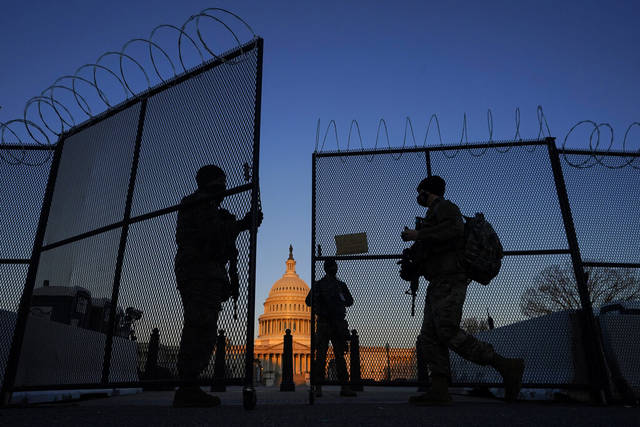https://triblive.com/news/world/capitol-police-to-begin-moving-back-fence-surrounding-complex/
Capitol Police to begin moving back fence surrounding complex

WASHINGTON — Congress is not facing the sort of threats that warrant the security fencing that has encompassed the Capitol complex since pro-Trump insurrectionists breached the Capitol on Jan. 6, according to Capitol Police, which will lead to imminent changes, but not complete removal, of the barrier.
Capitol Police told acting House Sergeant-at-Arms Timothy Blodgett that “there does not exist a known, credible threat against Congress or the Capitol Complex that warrants the temporary security fencing,” according to a memo sent Monday to members of Congress and staff. Therefore, the Capitol Police and the Architect of the Capitol will start making changes to the fencing structure this week.
Plans are to move the inner fence closer to the Capitol, remove the razor wire on that fence and permit more access through roads and sidewalks. There are also plans to remove the outer perimeter fencing and open Independence Avenue and Constitution Avenue for traffic toward the end of the week of March 22.
In some areas, the fence has already receded to allow for more traffic flow, including by Louisiana Avenue NW, Washington Avenue SW and on Third Street between Independence Avenue SW and Constitution Avenue NW.
In his memo, Blodgett did not give a timetable for how long the last vestige of fence would be around.
“The inner perimeter fencing will remain around Capitol Square as the (Architect of the Capitol) continues to make necessary security repairs to the Capitol building,” he stated.
In the coming weeks, Blodgett said in his message, the National Guard will reduce its presence at the Capitol, barring a change in security threat. Members have expressed concerns over how long the National Guard troops would stay at the Capitol and about how long the fence, which cuts off the Capitol from the public, will stay put.
The National Guard is drawing down troops supporting the mission in Washington, D.C. from 5,000 to 2,280, the amount currently authorized when the mission was extended on March 12 until May 23, according to Maj. Aaron Thacker, a spokesman for the Guard.
“We will be at a steady state with the authorized 2,280 in a few days,” Thacker said.
Delegate Eleanor Holmes Norton, D-D.C., has been vocal about her intent on having the fence removed, and joined local activists Saturday to protest the continued presence of the fence at its perimeter.
“I continue to press for the complex to be returned to the public, and we are making progress, as evidenced by the recent Task Force 1-6 report, which recommended against permanent above ground fencing at the complex,” she said in a statement, referring to a security posture review headed up by Retired Army Lt. Gen. Russel L. Honoré.
Emergency incidents are still top of mind for the sergeant-at-arms, prompting the SAA and the Capitol Police to host emergency procedures training for House members and floor staff.
There are three upcoming emergency procedures training events to review chamber-specific emergency procedures, protective actions and the use of escape hoods. At the training, members can ask questions and practice using the escape hoods, according to a separate email sent Monday by the sergeant-at-arms.
Honoré’s security assessment of the campus recommended the fence be replaced with a mobile fencing option that is easily put up and taken down. As a long-term solution, he calls for an integrated, retractable fencing system that is capable of securing the Capitol along with the office buildings.
In an opinion piece Honoré wrote for The Washington Post, the general wrote he doesn’t think the four miles of fencing will protect against another attack and that the fence is temporary until “more sustainable changes are made.”
Acting Capitol Police Chief Yogananda advocated in January for permanent fencing but has since appeared more open to other options.
Copyright ©2025— Trib Total Media, LLC (TribLIVE.com)
